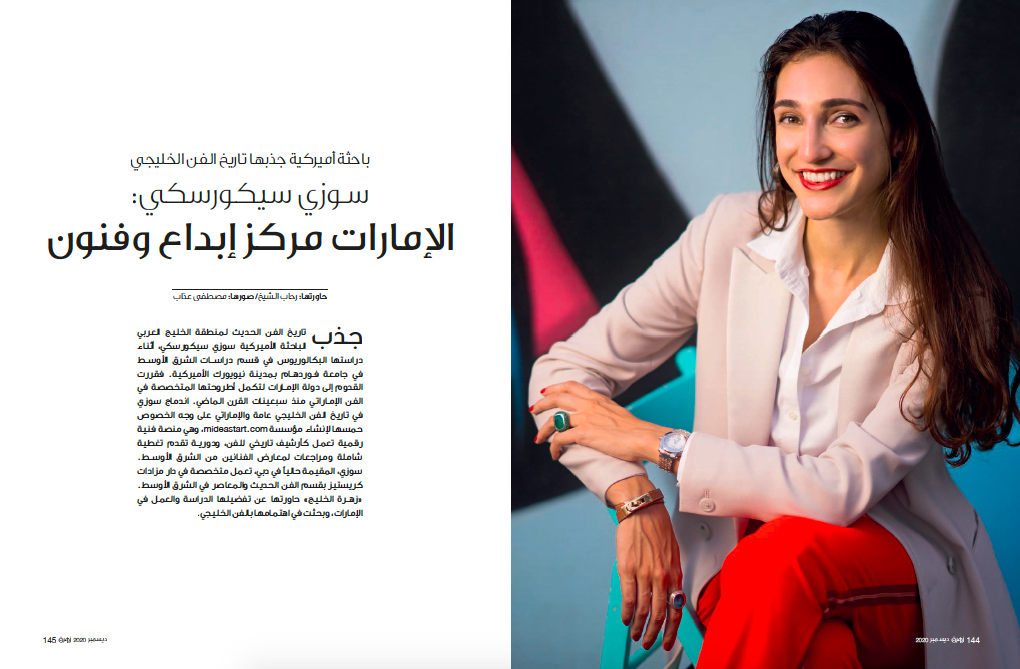Mid East Art founder Suzy Sikorski is featured in December 2020’s issue of ‘Zahrat Al Khaleej’ (زهرة الخليج) - the leading women's lifestyle magazine in the Arab world today!
“Read about my early inspirations researching in the Middle East and my current work archiving the Gulf art scene on Mid East Art. I share a few special places of mine in the UAE, favorite local food dishes and memories visiting so many artists studios and their families.
Tracing the early days along the Sharjah corniche, sunrise photography shoots along Dubai creek, trekking across the country to Khorfakkan, with too many servings of balaleet and luqaimat later!
My research has blessed me with the experience to be invited to so many local artist’s homes, having traditional meals and looking through old family photographs and investigating their archives found in their studios
One of the most special parts of these family visits is tracing the creativity that runs throughout the generations, whether it be across art, architecture, design, poetry or fashion - sometimes even cooking!” —Suzy
English translation of the Arabic article below:
Zahrat Al Khaleej: Why did you choose the UAE in particular? To study and work?
Suzy: Originally from New York, I was always interested in the Middle Eastern region since a child and learned about the UAE art scene while following the country’s institutional and gallery exhibitions, art fairs and auctions. The UAE continues to be such a multicultural place thriving in the arts and finding this as a central hub for the region, I chose to study at the American University of Sharjah in 2014, which inspired my art research and undergrad thesis in UAE art history since the 1970s. This research experience eventually awarded me a Fulbright scholarship in 2016 to Dubai and since then I have dedicated my work to documenting the local and regional art scene, both as an art researcher through my work running my digital art initiative Mid East Art, and as a Middle Eastern art specialist at Christie’s auction house.
Zahrat Al Khaleej: What have you seen in the UAE legacy and impact on you? How do you see the artistic movement in the Emirates?
Suzy: My research has blessed me with the experience to be invited to so many local artist’s homes, having traditional meals and looking through old family photographs and investigating the archives of the artists’ studio spaces. I also have met their families and have found the creativity that runs through the generations, whether it be across art, architecture, design, poetry or fashion - sometimes even cooking! It’s always exciting to see the children producing art inspired by their parents, there is always a creative element running through. It is so essential to my research to visit these spaces to understand the artist and their inspirations at a closer level and to see how this has impacted their artworks.
The arts movement in the UAE is continuously evolving and growing today, with so many movements reflective across multiple generations, also layered by a multidisciplinary approach to art production influenced by varying elements of art, architecture, design and literature. Now with art educational initiatives expanding and with social media, so many different communities are coming together, both physically and virtually these days.
My initial inspiration for my research of UAE artists was through studying the art collectives around the Gulf region that were practicing in the 1980s and 1990s. While piecing together the modern art history of the Gulf, I focused specifically in the UAE during my scholarship and recognized the UAE’s strong emphasis on regional and international exposure for the art community- whether in traveling or local exhibitions.
Zahrat Al Khaleej: What places have you visited and made an impression on yourself?
Suzy: I spend a lot of my mornings doing photography adventures across the UAE. Places that are close to my heart: Khorfakkan, Sharjah’s corniche area, Bastakiya and Bur Dubai.
Zahrat Al Khaleej: Do you prefer Middle Eastern food?
Suzy: Yes! I am vegetarian so have acclimated well to many spices and vegetable dishes.
Zahrat Al Khaleej: What about Emirati food and what do you eat from it?
Suzy: I’m always ready for an Emirati breakfast - balaleet with Arabic ghawa and luqaimat!
Zahrat Al Khaleej: What is the difference between the pioneering artists of the 1970s and today's artists from your research on this matter?
Suzy: The earlier pioneer artists faced many challenges in continuing their arts practices. They had very little resources - whether art historical texts and a society that did not understand contemporary art, so it was challenging both internally within the art community but also society accepting this. They struggled and persevered to dedicate their work to producing art, teaching in workshops, exhibiting and writing about art - which in turn, equipped the younger generation with the education and tools to become artists. Without social media it was important then to develop a network of artists for encouragement and support to continue. Now, society is more aware of the contemporary arts reinforced by museums, art fairs and cultural centers, and there are many opportunities for artists and scholars to learn about art history through fine art programs and many spaces to practice and exhibit their work, along with local arts initiatives supporting the community.
Zahrat Al Khaleej: What are the most prominent features of plastic art in the Emirates?
Suzy: There is not one unifying visual aesthetic to UAE fine art today, but instead it is multi layered and diverse across different artistic inspirations and forming differing movements, whether in calligraphy, conceptual or traditional, and classical realistic practices across painting, photography and installation. Today I have noticed trends of artists interested in nature and sustainability, their surroundings, and documenting the rapid shifts in their environment. Along with researching their family archives, taking into account the different generations.

